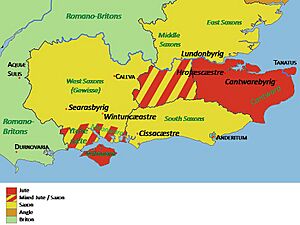Haestingas facts for kids
Quick facts for kids
Kingdom of Haestingas
|
|||||||||
|---|---|---|---|---|---|---|---|---|---|
| 6th century?–771? | |||||||||
| Capital | Hastings | ||||||||
| Common languages | Old English (Englisc) | ||||||||
| Religion | Paganism? Western Christianity (Roman Catholicism) |
||||||||
| Government | Monarchy | ||||||||
| History | |||||||||
|
• Established
|
6th century? | ||||||||
|
• Disestablished
|
771? | ||||||||
|
|||||||||
The Haestingas (also spelled Heastingas or Hæstingas) were an early group of Anglo-Saxons in Britain. We don't know a lot about them. They settled in the area that is now East Sussex sometime before the late 700s. One old record from the 1100s suggests that Offa of Mercia, a powerful king, conquered them in 771. However, the Anglo-Saxon Chronicle (a very old history book) shows they were still a separate group as late as the 1000s.
Contents
Who Were the Haestingas?
The Haestingas were a distinct group of Anglo-Saxons. They lived in the eastern part of what is now Sussex. This area is where the town of Hastings got its name. People believed they were different from the South Saxons, who lived in the western part of Sussex.
Early Settlements in Sussex
The story of the South Saxons begins in 477 AD. The Anglo-Saxon Chronicle says that Ælle of Sussex arrived with his three sons. They landed at a place called Cymenshore. This spot is thought to be near Selsey, in the southwest of Sussex.
However, discoveries from old burial sites tell a different story. They show that the main Anglo-Saxon settlements in the 400s were actually further east. These were between the River Ouse and River Cuckmere in East Sussex.
The Haestingas and Their Neighbors
East of Pevensey, near an old Roman fort called Anderitum, lived the Haestingas. This area was separated from the South Saxons by marshland and an estuary. The Haestingas' land stretched towards the border with the Kingdom of Kent.
Some old documents from the Kingdom of Sussex suggest there were two different ruling families. One king, Northelm (or Nunna), ruled in the late 600s and early 700s. His documents often mention another king named Watt (or Wattus). Historians think Watt might have ruled the Haestingas. This is because place names like 'Watt' or 'What' are found in the Hastings area. They are not found in western Sussex.
Changes in Power: Mercia and Wessex
Towards the end of the 700s, the Kingdom of Kent faced problems. The kingdom of Wessex was growing stronger under King Cædwalla. Wessex often raided Kent. In 686, Cædwalla attacked Kent with his brother Mul. The next year, the people of Kent killed Mul. Cædwalla then took over Kent in revenge.
Cædwalla later went on a trip to Rome and died there. Kent became stable again under King Wihtred. Ine became king of Wessex. Kent agreed to pay Wessex for Mul's death. This agreement might have included giving some border land to Wessex. Historians think the Haestingas might have come under Wessex's control as part of this deal. The southern kingdoms then had peace for about 25 years.
Mercian Rule and Later Identity
The peace ended when the Kingdom of Mercia grew powerful. A historian named Simeon of Durham wrote that Offa of Mercia defeated the Haestingas in 771. Mercian rule ended in 825. This happened when Egbert of Wessex defeated them at the Battle of Ellandun. Egbert then took over Essex, Kent, Surrey, and Sussex. This suggests that by then, the Haestingas had become part of Sussex.
However, the Haestingas kept their own identity for a long time. The Anglo-Saxon Chronicle mentions that the Danes attacked the Haestingas in 1011. This shows they were still seen as a distinct group even in the 11th century.
The Hastings region was naturally separated from the rest of Sussex. Marshlands to the west and a forest to the north isolated it. More marshland to the east separated it from Kent. This made it a unique area.
Where Did They Come From?
Some people have suggested the Haestingas might have come from Frankish areas (modern-day France). This idea came from the name Watt, a sub-king, and a place called Watten in northern France.
However, a more likely idea is that the Haestingas were Jutes. The Jutes were another Germanic group who settled in Britain. They might have moved to Sussex from Kent. Kent was one of the first Anglo-Saxon kingdoms to become Christian. This happened around 580 AD when the Frankish princess Bertha married the Kentish king Æthelberht of Kent. She was Christian and brought a bishop with her.
Since there isn't much archaeological evidence for the Haestingas, it's possible they were already Christian when they arrived in Sussex. This would explain why their burial sites might not look typically pagan.
What Does "Haestingas" Mean?
The name "Haestingas" comes from Old English. It means "settlement of Haesta's People." Haesta would have been the leader or chief of the group. The ending "-ingas" means "people" or "followers."
Some have wondered if Haesta was an ancestor of the Viking leader Hastein. Hastein invaded Kent in 892. But there is no real proof to support this idea.
See also
Images for kids



